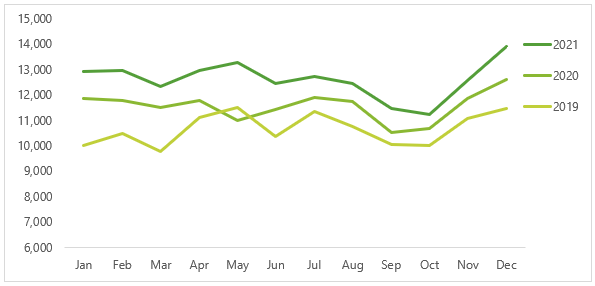Year-over-Year (YOY) is a method to compare a company’s recent two or more financial events on an annual basis. It gives an insight into the financial performance of a company or business and gets to know whether the performance is improving, static, or worsening.
Some key points about Year-over-Year (YOY):
- It is simple and easy to calculate.
- It is especially useful in terms of revenue data comparison.
- It performs the cross-comparison of data sets.
- Macroeconomic variables such as GDP-, and money supply are understood by the YOY method.
- It helps to indicate the overall performance of a company in a particular season.
How to Calculate YOY?
Year-over-year aims to perform a comparison of recent financial performance. But the question is how to calculate the YOY growth rate. In order to calculate the YOY growth rate, the current period amount is divided by the prior period amount, and then one is subtracted to get to a percentage rate.
Formulae for Calculating YOY
So below is the formula to calculate the year-over-year (YOY) growth rate:
Year over Year Growth (YOY) = (Current Period Value ÷ Prior Period Value) – 1
YOY Growth Calculation Example
For example, let’s say a company had revenue of $100,000 in 2021 and $ 120,000 in 2022. To calculate the YOY growth for revenue, you would subtract $100,000 (the revenue from 2021) from $120,000 (the revenue from 2022) to get $20,000. Then you would divide $20,000 by $ 100,000 to get 0.2 or 20%. So the company is to get 0.2 or 20%. So the company’s revenue grew by 20% YOY.
- Year over Year Growth (YOY) = (Current Period Value ÷ Prior Period Value) – 1
- YOY Growth = ($ 120,000 / $100,000) – 1 = 20%
Economic Indicators that use YOY Growth
Even though the YOY method helps a lot in many economic indicators but here we are going to talk about some most commonly used metrics for conducting a year-over-year comparison:
- Inflation – The YOY method gives an idea about inflation in the market. Like trend in inflation.
- Unemployment rates – YOY method analyzes the workforce participation rate trend.
- GDP – How much gross domestic product is a country producing? Well, the YOY method helps to understand it.
- Interest rates – Are we in a rising or falling interest rate environment? There is also the YOY method to help.
Advantages of Year-Over-Year Growth
There are several advantages of analyzing year-over-year growth for business owners and retailers, including
- A direction for business strategy
Year over Year growth helps businesses and companies to make better strategies. Any business with a maximum of 13 months can use the method YOY. The data it provides can help in the direct business strategy.
Example: If sales figures are high but YOY growth is low. It can mean there are some problems with manufacturing, production, costs, etc.
- Fast financial information for lenders
If we talk about monthly, quarterly metrics, or YOY growth. So YOY growth can offer far better long-term results than monthly or quarterly metrics. The information given by YOY growth is very helpful for lenders, banks, and decision-makers who want simple and straightforward statistics on your company’s growth.
- Provides top-level insight for seasonal businesses
YOY can show the most accurate picture seasonality compared to MoM metrics (month over month). In the case of MOM, it is hard to get proper insight from only the base of a month period and a little bit harder to know about the long-term issues that can affect long-term growth.
But in the case of YOY, it helps to know proper insight into business, high-lights the issues, and what steps should be taken for better long-term growth.
Some Real-World YOY Growth Examples
YOY growth is popularly used in retail but apart from here, there are plenty of other sectors as well where YOY plays a good role. So let’s dig into some real-world examples of YOY growth:
- Manufacturing
From time to time some factories touch new heights whereas some factories drown in their careers and this depends on how efficient their production lines are. In the field of manufacturing, it is important to know several factors to grow and improve sales. Taking insight from manufacturing growth, machine performance is much greater to understand the process. YOY helps here to understand the process and provide very well outcomes to tackle future goals.
- Healthcare
The YOY method helps in the healthcare system as well. When it comes to measuring things like patients served or cost per patient, it’s vital to look at YOY figures with different policies.
- Logistics
In order to run a successful industry, YOY growth can show a bright path.
If a company wants to remain efficient and effective in the market. The YOY method can help with this. It pinpoints and highlights issues and activities of the company on a yearly bases and allows to make better strategies for long-term success.
Cons of YOY Measurements
- The company can hide any particular month problem by only comparing the full-year metrics YOY.
- In a way, it is not enough to understand the whole performance of a company. That’s why apart from YOY. The help of other metrics should be taken.
- It provides meaningless outcomes even if a one-time duration has had terrible growth.
Some Alternatives to YOY Growth
However, Year over Year is convenient for the calculation of your business’s measurable events. But it’s not the only to do these tasks even there are several other methods that can help you get a clearer picture of performance. You may also want to calculate the following:
- Month to date (MTD): MTD performance is calculated by way of subtracting the preliminary price at the opening of the cutting-edge month from the cutting-edge value, dividing it by using the preliminary value, and multiplying by using a hundred to get a percent.
- Quarter to Date (QTD): QTD measures a KPI from the commencing of the quarter up till the contemporary date, however now not along with today’s date
- Month over Month (MoM): MoM means the distinction between this month’s whole (sales, users, etc.) and the remaining month’s total.
Conclusion
Overall, YOY is a useful tool for measuring growth and identifying trends over time in any industry or business.



